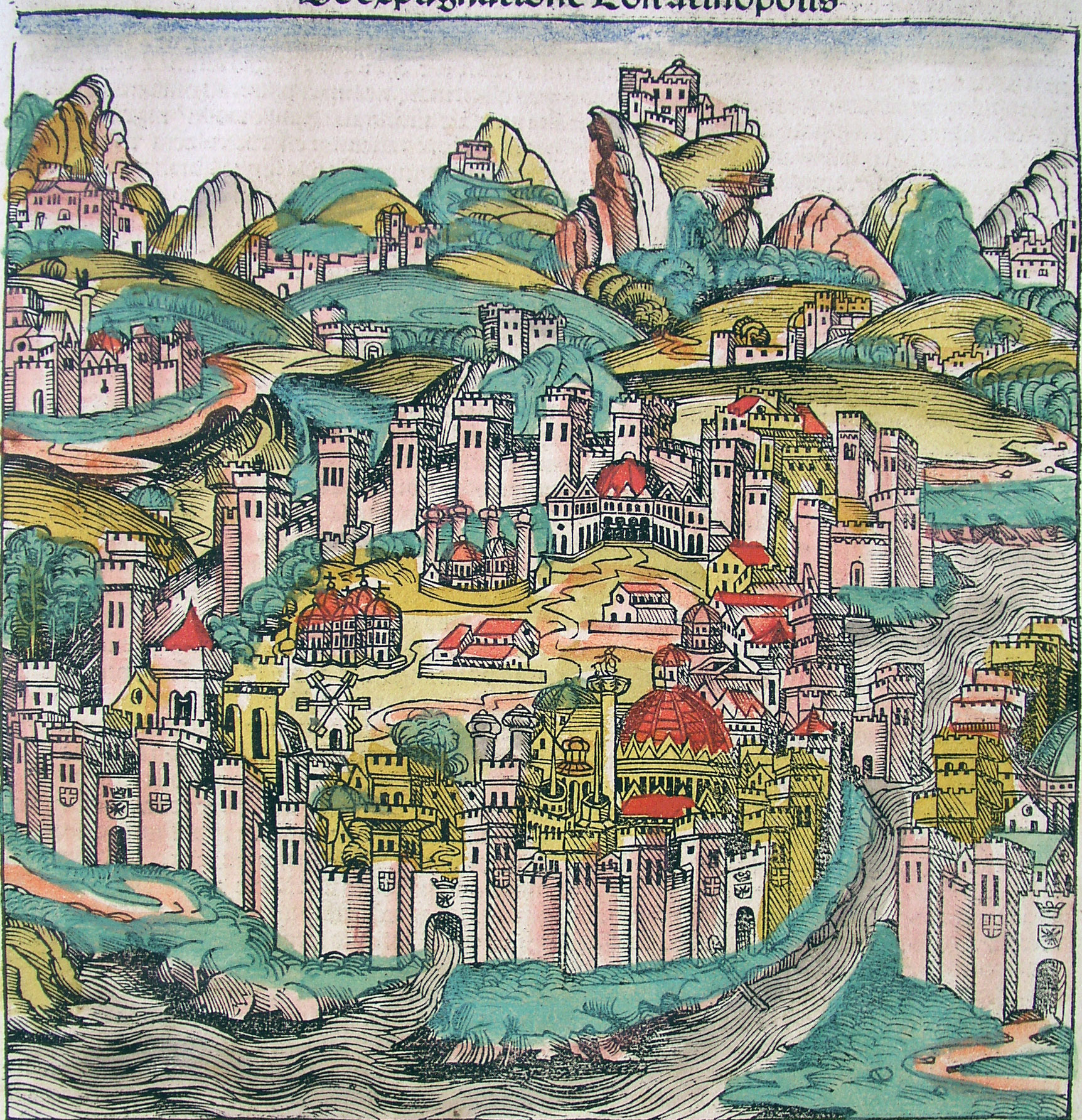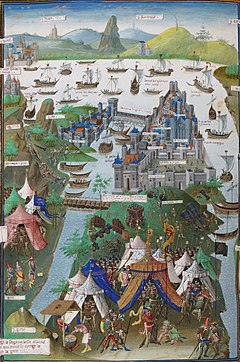 |
| Click here to embiggen |
Oh, what a noble and beautiful city is Constantinople! How many monasteries and palaces it contains, constructed with wonderful skill! It would take too long to describe all the wealth that is there of every kind, of gold, of silver, all kinds of clothes, holy relics... There are, I think, around twenty thousand eunuchs living there always.
~ Fulcher of Chartres (1059 -??) (Historia Hierosolymitana, during the First Crusade, 1096)
They found the Turks coming right up under the walls and seeking battle, particularly the Janissaries ... and when one or two of them were killed, at once more Turks came and took away the dead ones ... without caring how near they came to the city walls. Our men shot at them with guns and crossbows, aiming at the Turk who was carrying away his dead countryman, and both of them would fall to the ground dead, and then there came other Turks and took them away, none fearing death, but being willing to let ten of themselves be killed rather than suffer the shame of leaving a single Turkish corpse by the walls.
Nothing will ever equal the horror of this harrowing and terrible spectacle. People frightened by the shouting ran out of their houses and were cut down by the sword before they knew what was happening. And some were massacred in their houses where they tried to hide, and some in churches where they sought refuge... they were intent on pillage and roamed through the town stealing, disrobing, pillaging, killing, raping, taking captive men, women, children, old men, young men, monks, priests, people of all sorts and conditions . . . There were virgins who awoke from troubled sleep to find those brigands standing over them with bloody hands and faces full of abject fury. This medley of all nations, these frantic brutes stormed into their houses, dragged them, tore them, forced them, dishonored them, raped them at the cross-roads and made them submit to the most terrible outrages.
 |
| (wiki) The last siege of Constantinople, contemporary 15th century French miniature |
Today is the anniversary of the fall of Constantinople in 1453 (wiki) to an Ottoman army under the 21-year-old Sultan Mehmet II after a siege of seven weeks. The last Byzantine emperor, Constantine XI Paliailogos, died in the final defense of the city, and the ensuing orgy of pillage and massacre brought the eastern Roman empire to a decisive end.*
Founded as Byzantium in the 7th century B.C. by Greek colonists from Megara, Constantinople (now Istanbul) sits at the junction of the Sea of Marmara and the Bosphorus, which leads to the Black Sea, about 15 miles to the northeast. This strategic location led to its becoming an ancient entrepot for trade between the east and west, and in A.D. 330, the Roman emperor Constantine made it the capital of his eastern empire, which - as the Byzantine Empire - outlasted the fall of Rome itself by nearly 1,000 years. After the sack of the city by the Fourth Crusade in 1204, the Byzantine Empire never regained its former glory, and by the time of its final defeat, it had been whittled down by the Ottoman Turks to little more than the capital itself and a small hinterland.
 |
| Mehmet entering the city after three days of rape and plunder |
The loss of Constantinople was a major shock to Christendom and particularly to the Greek and Russian Orthodox communities, for whom the city had been their spiritual nexus. During its subsequent "golden age" and 19th-century decline, Constantinople remained the capital of the Ottoman Empire until the end of World War I, when what was left of the old Ottoman territories became today's Republic of Turkey with a new capital at Ankara.**
French aviator and writer Antoine de Saint-Exupéry (1900-1944) wrote in Flight to Arras,
"The injustice of defeat lies in the fact that its most innocent victims are made to look like heartless accomplices. It is impossible to see behind defeat the sacrifices, the austere performance of duty, the self-discipline and the vigilance that are there - those things the god of battle does not take account of."
* N.B. In addition to the Byzantine Greeks defending the city, there were large contingents of Venetians, Genoese, Sicilians, and natives of the Papal States.
** However, it wasn't until 1930 that the Turkish government officially changed the name of the city to Istanbul.
Here's a brief documentary:
And you can't do a piece on Constantinople without the classic song Istanbul (Not Constantinople) - the video below is a Tiny Toons production using the version by They Must Be Giants, but for the music alone I prefer the original 1953 version by The Four Lads.
Istanbul was Constantinople
Now it's Istanbul, not Constantinople
Been a long time gone, ol' Constantinople
Now it's Turkish delight on a moonlit night...

There is also a record "Constantinople," which consists primarily of spelling out the name.
ReplyDelete